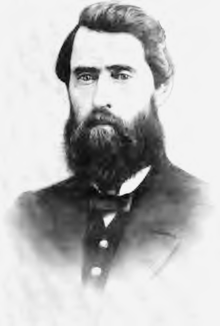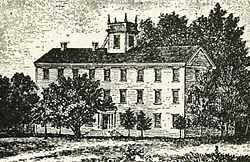Methodist Mission
The Methodist Mission was founded in Oregon Country in 1834 by the Reverend Jason Lee. Started by United States Protestant missionaries to educate the Native Americans in the Willamette Valley, it developed as an important center for European-American politics and economics in the early settlement period of Oregon. People associated with the mission set up the first government in Oregon. In 1842, settlers established the Oregon Institute as the first school in the territory for European-American children and bought a mission building originally intended for Native children. The mission closed down about 1844.
The mission was founded about five years after 90 percent of the Native Americans in the lower Willamette Valley had died as a result of infectious disease epidemics. The mission did some teaching and set up trading posts, but accomplished little in terms of conversions to Christianity.
Foundation

In 1831, several Nez Perce Indians were said to have traveled to St. Louis, Missouri and met with General William Clark of the Lewis and Clark Expedition to inquire about the “white man’s God” from the General.[1] This spurred a missionary movement to convert the Native Americans to Christianity.[1] In 1834 the Methodist Church sent the Reverend Jason Lee, his nephew the Reverend Daniel Lee, Cyrus Shepard, Philip Leget Edwards, and Courtney M. Walker overland to preach to the Flathead Indians (Salish).[1] The group contracted with the entrepreneur Nathaniel Jarvis Wyeth to travel overland with his party and to ship supplies around Cape Horn on Wyeth’s ship May Dacre.[1]
Lee ignored the missionary board’s instructions and traveled to Oregon Country, where he set up a mission in the Willamette Valley.[1] John McLoughlin, district director of the Hudson’s Bay Company recommended the Willamette Valley as a better spot for settlement than the area to the north where the Flathead lived.[2] The mission was 60 miles up the Willamette River from its junction with the Columbia.[1] The mission built a cabin, barn, and fencing before the first winter set in.[1]
Operations
In the early years of the Mission, Lee also preached to the Catholic French Canadian settlers of the French Prairie.[2][3] He performed marriages and baptisms for that group as no Catholics priests were yet in the Willamette Valley.[2] This continued until François Norbert Blanchet arrived and held the first Mass on the French Prairie on January 6, 1840.[1]

Soon after building the Mission, Lee and his men built the Indian Mission School to be used to teach the Native American children the ways of Western society.[1] Philip Edwards was the first teacher of the group which totaled around 30 students.[1] These students came from both Native tribes and from the families of the French Canadian settlers, many of whom had married Native Americans.[1] In 1835, the first class had 14 Native students. Seven died and five ran away from the school.[4] The following year the school admitted 25 students. Sixteen became sick, and only one student converted to Christianity.[4]
In 1837, Dr. Elijah White and seven other missionaries arrived aboard the ship Hamilton to reinforce the Mission.[1] Others joining from this group include Alanson Beers and William H. Willson, and several women.[1] The women included White's and Beers' wives, Elvira Johnson, Susan Downing, and Anna Maria Pittman.[5] Five children also arrived with the party, with the entire group arriving in May.[5] Men of the settlement and single mission women promptly chose mates. On June 16, 1837, Cyrus Shepard married Susan Downing and Jason Lee married Anna Pittman.[5] Two more ministers, David Leslie and H. K. W. Perkins, arrived at the Mission on September 7, 1837.[5]
In March 1838, Jason Lee and Phillip Edwards traveled to the East to recruit more settlers for the Oregon Country.[5] On this journey they carried a petition signed by 29 pioneers including Ewing Young, asking the United States Congress to create a territory out of Oregon and extend its jurisdiction over the region.[5] While Lee was away, his wife died in childbirth.[5] Lee also lectured along the way and on the East Coast, leading to the raising of $42,000 for the cause. In addition, he attracted nearly 40 adults (with 18 children), who sailed to Oregon and the Mission.[5]
This second group arrived at the Mission in October 1839 aboard the ship Lausanne, increasing the number of people at the Mission to sixty.[1] They were known as the “Great Reinforcement” and included had 32 men and women, along with 18 of their children.[6][7] The Methodist Mission opened branches at Nisqually north of the Columbia River, on the Clatsop Plains near the mouth of the Columbia, and at the falls on the Willamette River near what is now Oregon City.[8] Notable arrivals with this group included Doctor Ira L. Babcock, George Abernethy, Alvin F. Waller, Josiah Lamberson Parrish, Gustavus Hines, Lewis H. Judson, W. W. Kone, Joseph H. Frost, and J. P. Richmond.[5]
Mission Bottom
The Methodist Mission was originally located on the Willamette River at the present-day Willamette Mission State Park, in an area known as Mission Bottom.[9] The missionaries built the Mission, and operated a small retail store that traded with the French Canadian settlers and the Native Americans.[10] The Mission traded surplus manufactured goods for items such as lumber or food stuffs.[10] In 1837, the missionaries added a large granary and hospital to the compound.[5]
Beginning in 1840, the Methodists began to move from Mission Bottom.[5] That year Jason Lee moved to the Mission Mill site in what is now Salem, while some others transferred to the Willamette Falls branch.[5] In 1841, the Indian Manual Labor School was re-located to Chemeketa near Salem.[5] After George Gary replaced Lee in 1844, he sold off the remaining buildings at Mission Bottom.[5] With the flood in 1861, all the old mission buildings at the site were washed away except the granary and hospital.[5]
The Dalles

Jason Lee’s nephew Daniel Lee established a branch mission at The Dalles along the Columbia River.[1] Rev. Daniel Lee and Rev. Henry K. W. Perkins established The Dalles Mission on March 21, 1838, under the direction of Jason Lee. The mission there became known as Wascopam, named for the Wasco tribe at that location.[11] Alvin Waller was transferred to this branch in 1840 from the Willamette Falls location, and the Wascopam Mission was at first successful in converting the Native Americans.[12] The mission consisted of a schoolhouse, garden, stable, barn, and two dwellings along with a cleared pasture adjacent to the wood huts used by the Native American villagers.[12] Missionaries used Pulpit Rock at the site to preach to the natives.[1]
In 1847, the Wascopam Mission was sold for $600 to Marcus Whitman, located near what is now Walla Walla, Washington. After the Whitman Massacre later in 1847, survivors returned the property to the Methodist Mission. It did not use the mission again and the buildings decayed. The United States Army burned the structures after erecting Fort Dalles.[12] The federal government paid the Methodists $24,000 for the land, but they later had to return $23,000 when lawsuits determined the Methodiests had never obtained good title to the land.[12]
Willamette Falls
At the Willamette Falls station of the Mission, the missionaries built a storehouse to use in the trade of goods.[10] In August 1842, the main mercantile store of the Mission was transferred to this location, in what became Oregon City.[10] George Abernethy was appointed as head of the retail operation.[10] In 1844, the Methodist Mission ceased all secular business, such as the mercantile trade at Oregon City.[10]
Astoria
Joseph H. Frost and William Kone were sent to the Clatsop Plains at the mouth of the Columbia River after arrival in May 1840 as part of the Great Reinforcement.[7] The Clatsop, the local tribe, assisted the missionaries in the construction of their house.[7] The missionary outpost was unsuccessful as Frost was unable to convert any Natives during his three years there.[7] In 1843, Reverend Parrish was placed in charge of the mission, replacing Frost.[5] The next year the mission was discontinued, and Parrish purchased the facility from the missionary board and settled there.[5]
Mission Mill
The mission moved to present-day Salem, near where the Mission Mill Museum is located.
Demise
Beginning in 1829, infectious disease was responsible for high fatalities among Native Americans in the Willamette Valley. By what was later called the Columbian Exchange, settlers introduced Eurasian diseases long endemic to their society, but the natives had little or no immunity to these. Their populations were decimated. Historians estimate that nearly 90% of the Native Americans in the Lower Columbia region died during the 1829 epidemic.[13]
With few natives to convert, the Mission soon had little purpose.
Legacy

In Salem on January 17, 1842 at Jason Lee’s home, a group of settlers met and formed the Oregon Institute as a school for the Euro-American children in the area.[5] A ten-person board of trustees was created; they selected the Wallace House three miles north of Salem to serve as the school.[5] At that time the Mission was building a new three-story structure to serve as a school for the Native Americans.
With the Mission closing, in 1844 it sold the building to the Institute for $4,000.[5] That year the school opened with Chloe A. Clarke Wilson as the first teacher of the school, considered the first for European-American children west of the state of Missouri.[5] (Note: Early Oregon histories bragged that this was the first school for European Americans west of the Mississippi River, but St. Louis Academy was founded by Jesuits in Saint Louis, Missouri in 1818.) The Oregon Institute developed into Willamette University in 1853.[5]
See also
References
- ↑ 1.0 1.1 1.2 1.3 1.4 1.5 1.6 1.7 1.8 1.9 1.10 1.11 1.12 1.13 1.14 1.15 Horner, John B. (1919). Oregon: Her History, Her Great Men, Her Literature. The J.K. Gill Co.: Portland.
- ↑ 2.0 2.1 2.2 Skinner, Constance Lindsay (1920). Adventurers of Oregon: A Chronicle of the Fur Trade. Yale University Press.
- ↑ Clarke, S.A. (1905). Pioneer Days of Oregon History. J.K. Gill Company.
- ↑ 4.0 4.1 Notable Oregonians: Jason Lee - Missionary, Pioneer, Oregon Blue Book
- ↑ 5.0 5.1 5.2 5.3 5.4 5.5 5.6 5.7 5.8 5.9 5.10 5.11 5.12 5.13 5.14 5.15 5.16 5.17 5.18 5.19 5.20 5.21 Corning, Howard M. Dictionary of Oregon History. Binfords & Mort Publishing, 1956.
- ↑ Oregon Blue Book: Oregon History: Souls to Save
- ↑ 7.0 7.1 7.2 7.3 J.H. Frost Journal, The Oregon History Project
- ↑ Clackamas County, 1800 to 1843
- ↑ Oregon State Parks
- ↑ 10.0 10.1 10.2 10.3 10.4 10.5 Chapman, J. S. (1993). French Prairie Ceramics: The Harriet D. Munnick Archaeological Collection, circa 1820-1860 : A Catalog and Northwest Comparative Guide. Anthropology Northwest, no. 8. Corvallis, Or: Dept. of Anthropology, Oregon State University.
- ↑ Boyd, Robert (1996). People of The Dalles: The Indians of Wascopam Mission. University of Nebraska Press.
- ↑ 12.0 12.1 12.2 12.3 "The City at The Dalles". Settling the Oregon Country. End of the Oregon Trail Interpretive Center. Retrieved 2007-09-13.
- ↑ "Spreading Old World Contagions", Oregon Historical Society